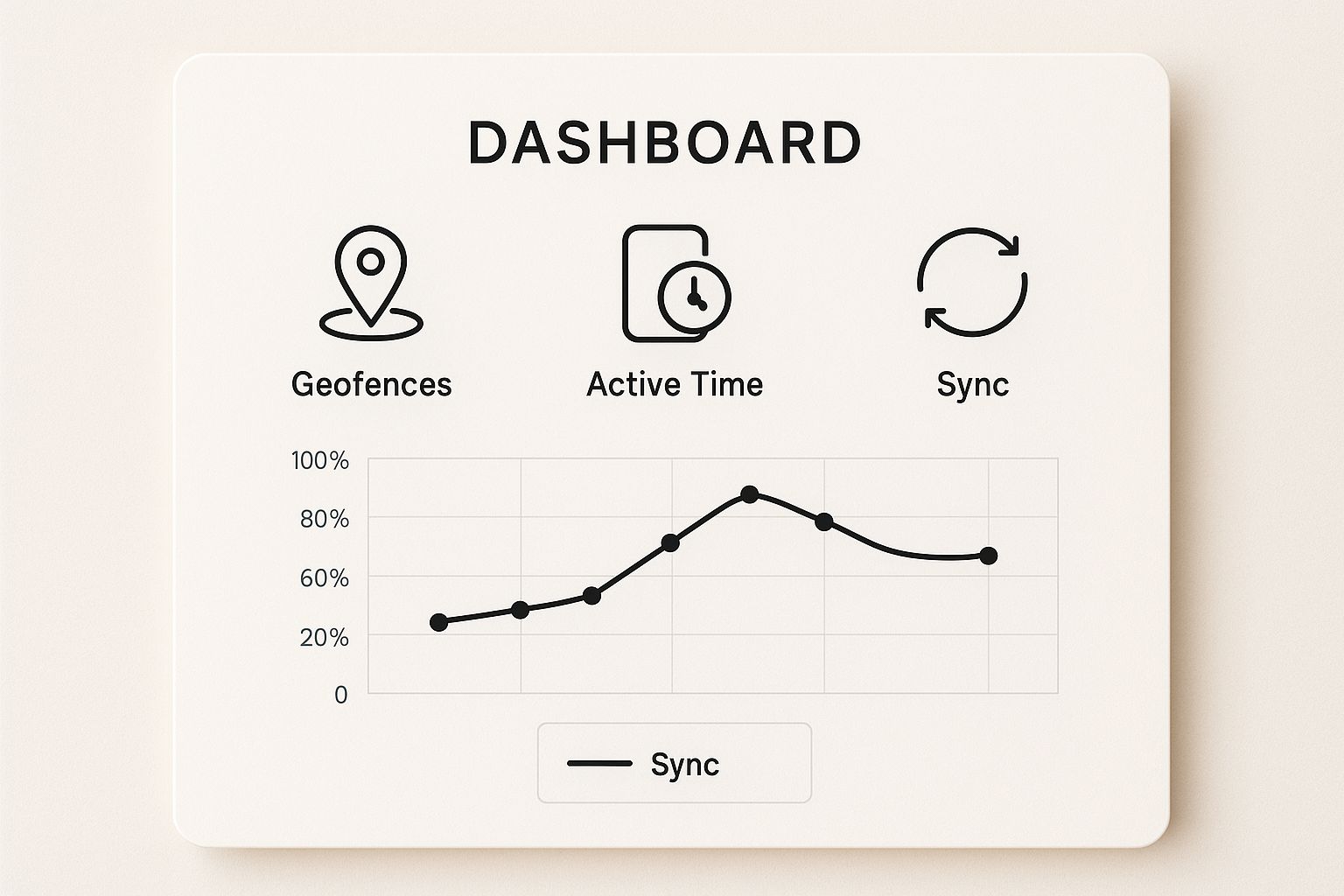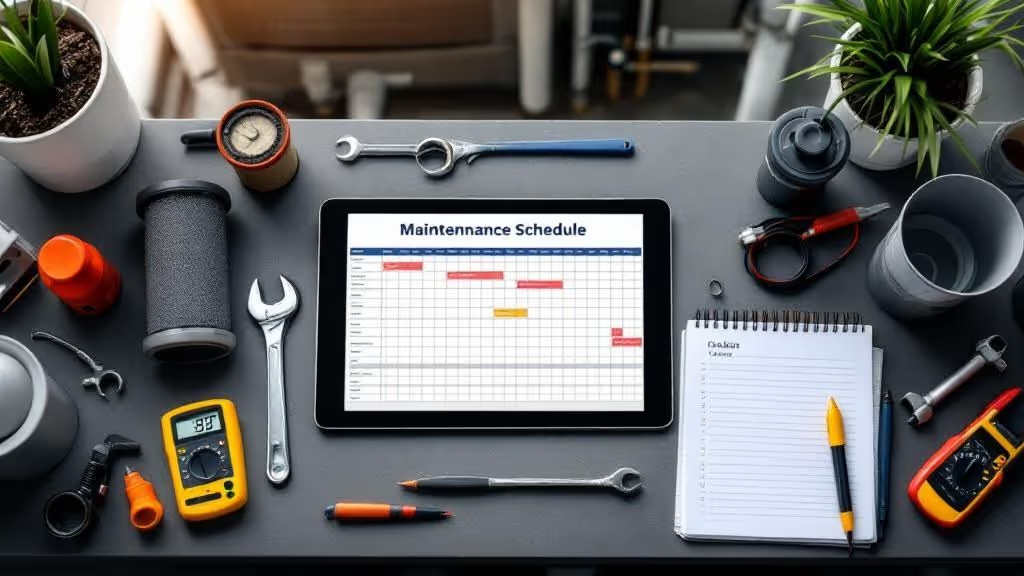Understanding Field Service Time Tracking

This image shows the projected growth of the Field Service Management market. The key takeaway? A significant expansion is expected in the coming years. This highlights the growing need for efficient field service operations, especially reliable time tracking. This growth is driven by the demand for better customer experiences and the use of technologies like augmented reality.
Think of field service time tracking as a GPS for your field operations. It gives you critical data, guiding your team towards top performance and informing your strategic choices. This isn't about monitoring every minute; it's about giving your field team the resources to succeed while providing you with the insights to manage everyone effectively.
Beyond Punch Cards
Traditional timekeeping methods, designed for office settings, don't work well in the dynamic field service world. Imagine a technician stuck in traffic, encountering unexpected problems on-site, or managing jobs of varying complexity. A simple punch-in/punch-out system can't capture the reality of these situations.
A quick repair might take 30 minutes, while a complex installation could last for hours. This difference makes accurate field service time tracking crucial for both fair employee compensation and correct billing.
The Digital Transformation
We've moved past clipboards and paper timesheets. Today’s digital tools provide real-time location tracking, automated updates on job progress, and seamless integration with your current processes. This means technicians can focus on their work, confident their time is accurately logged, while you gain valuable data for optimizing operations.
This digital shift is clear in market trends, with the global field service management (FSM) market predicted to grow from $6 billion in 2024 to $11.5 billion by 2030, at a CAGR of 11.4%. This growth is fueled by the increasing demand for better customer experiences and the adoption of new technologies. Learn more about these market insights.
Meeting Field Service Challenges
Managing remote teams, handling unpredictable job lengths, and maintaining accountability are just a few of the hurdles field service organizations face. Effective time tracking gives you the information you need to tackle these challenges directly.
It helps you allocate resources wisely, spot areas for improvement, and guarantee accurate billing and payroll. The result? A more profitable and efficient operation. By understanding the power of field service time tracking, you can turn a simple administrative task into a valuable strategic asset.
The Hidden Costs of Poor Time Tracking
Imagine your favorite restaurant having no idea how long it takes to cook each dish. Chaos, right? That's the reality for many field service businesses without solid time tracking. The impact isn't always obvious, but it can hit every part of the operation, from lost profits to stressed-out technicians and unhappy clients.
The Domino Effect of Inaccurate Time Data
Let's say your technician tells Mrs. Johnson they'll be there between 10 AM and 2 PM. Without good data on similar jobs, that's just a hopeful guess. The technician rushes, Mrs. Johnson rearranges her entire day, and ultimately, your customer satisfaction takes a hit.
This seemingly small hiccup can snowball. Inaccurate time tracking can cause billing disputes over "unbillable" time and payroll confusion when timesheets don't match up with completed jobs. This administrative mess eats up valuable time and money.
Quantifying the True Cost
The cost of bad time tracking isn't theoretical; it's real money. One HVAC company realized they were losing $3,200 every month in unbilled time. A plumbing company found that poor scheduling, based on bad time data, led to technician burnout and a 23% higher turnover rate.
These stories show the financial drain of inefficient time tracking. The costs extend beyond lost revenue to higher admin expenses, lower employee morale, and more expensive recruiting.
The Freelance Factor
The growing reliance on freelance technicians makes accurate time tracking even more critical. By 2025, it's predicted that 50% of field technicians and service personnel will be freelancers. Yet, even in 2020, 25% of field service organizations (FSOs) still used spreadsheets for scheduling. Discover more insights on these industry trends.
With contract workers, accurate data is vital for fair pay, consistent service quality, and cost control. You can't manage what you can't measure. This highlights the importance of a robust time tracking system, especially as the workforce changes.
From Guesswork to Precision
Switching from estimated times to accurate tracking is like trading a rough sketch for a detailed blueprint. It helps you make smart decisions, use resources wisely, and improve how your entire operation runs. This shift isn't just about tracking time; it's about capturing value.
Time Tracking Features That Actually Matter
Not all field service time tracking features are created equal. Some are like adding a turbocharger to your team's efficiency, while others just clutter the dashboard. Let's explore the features that truly move the needle.
Location Verification and Automated Clock-In
Think of GPS-based automatic clock-in/out as a digital handshake with your clients, building trust and transparency from the moment a technician arrives. Imagine: a technician pulls up to a job site, and the system automatically logs their arrival. No more disputes about start times, just clear, verifiable data that benefits everyone. This transparency strengthens client relationships, replacing potential friction with reliable information.
Imagine a world where every field service visit starts with a timestamp everyone agrees on.
Real-Time Job Progress Updates
Real-time job progress tracking is like giving your customers a front-row seat to the action. Instead of vague "we'll be there soon" messages, you can offer precise, data-driven updates. A client can receive notifications when a technician is en route, when they're on-site, and when the job is wrapped up. This level of detail keeps them informed and confident in your service. No more guessing games, just real-time insights.

This infographic showcases a streamlined dashboard with essential features like geofencing, mobile timers, and real-time synchronization. It’s a visual representation of how user-friendly field service time tracking can be, simplifying life for both technicians and managers. Think of it as a control center that provides a clear overview of everything happening in the field.
Mobile-First Design and Offline Functionality
For field technicians, mobile isn't just a convenience; it's a necessity. A good time tracking system understands this, offering mobile-first interfaces designed for ease of use, even in tough conditions. Picture a technician wearing gloves, needing to log time with one hand – the app should make this simple and intuitive. And what about areas with spotty internet? Offline functionality ensures that time data is stored locally and syncs automatically when a connection is available, preventing lost entries and frustration.
Seamless Integrations for Streamlined Workflows
Integrations are the glue that holds your operations together. Time tracking shouldn't exist in a vacuum. It should connect seamlessly with your invoicing system to eliminate billing delays, with payroll for accurate compensation, and with your Customer Management System (CMS) to provide a complete service history. This interconnected approach breaks down data silos and keeps everything running smoothly, like a well-oiled machine. Think of it as creating a central nervous system for your business, where information flows effortlessly between different functions.
Focusing on ROI and Avoiding Feature Overload
Just because a feature exists doesn't mean it's essential. Some features might sound impressive on paper but offer little practical value. The real trick is choosing tools that directly address your specific challenges and contribute to measurable improvements. This targeted approach maximizes your return on investment and avoids the digital clutter of unnecessary features. Focus on the features that solve real problems and drive real results.
To help you prioritize, let's look at a breakdown of essential versus nice-to-have features:
Essential vs. Nice-to-Have Time Tracking FeaturesA comprehensive comparison of time tracking features based on their impact on productivity and ROI.
This table highlights the features that deliver the biggest bang for your buck. While advanced features can be beneficial down the line, focusing on the essentials first ensures you’re building a solid foundation for efficient time tracking. By prioritizing essential features, you can achieve quick wins and build momentum towards more sophisticated capabilities later on.
How Automation Transforms Field Service Operations
Welcome to a new era where technology works hand-in-hand with human expertise in field service. Think of smart automation as a tireless, always-on operations manager, constantly tweaking workflows and digging deep into data for insights. Let's explore how this transformation is playing out in the real world.
Smart Scheduling and Optimized Routes
Smart scheduling algorithms are like giving your technicians a productivity boost. These systems analyze historical data, current traffic conditions, and the complexities of each job to create the most efficient routes. This means technicians can complete more jobs each day. For example, imagine an electrical services company that used to struggle to fit in all their appointments. After implementing AI-powered scheduling, they saw their daily job completion rate jump by 35%. This system considered each technician's skills, their location, and the estimated time for each job. Data-driven automation and predictive analytics are becoming essential tools in field service time tracking and management. AI-powered smart scheduling helps technicians squeeze in one or two extra jobs per day by optimizing routes and appointment times. Plus, with an aging workforce, more and more businesses – 56% in fact – are adopting remote support technologies to meet the challenges. Discover more insights on these field service trends.
Predictive Analytics for Proactive Staffing
Predictive analytics helps managers anticipate staffing needs. Instead of being caught short-handed, these systems act like a workforce crystal ball. They analyze seasonal patterns, historical demand, and even local events to predict busy periods. This foresight allows for proactive staffing adjustments, ensuring the right team is in place at the right time.
Automated Reporting and Actionable Insights
Automated reporting transforms raw time tracking data into valuable insights. Instead of just numbers on a spreadsheet, you get information that can actually help your business. It can identify technicians who could benefit from extra training, pinpoint job types that consistently take longer than expected, and highlight your most profitable clients. This data empowers managers to make smart decisions that improve both service quality and the bottom line. When evaluating time tracking features, consider integration with other systems. Here's an article on Timers.
Anomaly Detection and Opportunity Identification
Machine learning algorithms can detect anomalies in time tracking data, acting like a detective looking for unusual clues. These systems flag unusual patterns that might indicate a problem or an opportunity. For example, if a technician's average job completion time suddenly increases, it might suggest they need additional training or support. This proactive approach allows you to address potential problems before they become major issues, and capitalize on opportunities for improvement.
Empowering Human Decision-Making
The ultimate goal of automation isn't to replace human judgment, but to give it a boost. By providing managers with better data and insights, these systems empower them to make strategic, informed decisions that drive operational excellence. It's like giving your managers superpowers, enabling them to see patterns and make decisions with greater clarity and confidence.
Avoiding Common Time Tracking Mistakes
Even the best field service time tracking system won't magically improve your operations. In fact, a poorly implemented system can actually make things worse. Let’s explore some common pitfalls and how to steer clear of them.
The Surveillance Trap
Imagine your field technicians as seasoned explorers, charting unknown territories each day. Now, picture handing them a tracking device, not as a helpful map and compass, but as a tool to monitor their every move. That’s the surveillance trap. When field service time tracking feels like Big Brother, technicians might get creative with their reporting, making the data less useful.
Instead, present time tracking as a tool that empowers technicians. It’s a way for them to showcase their efficiency, ensure accurate payroll, and justify the value they bring. This positive framing encourages honest reporting and boosts team morale.
The Over-Complication Curse
Think of a plumber trying to fix a leaky faucet while simultaneously filling out a seventeen-page form. Sounds ridiculous, right? That’s what over-complicating time tracking feels like. We've seen companies demand excessive data points, only to have their technicians abandon the system altogether. They'd rather face a frustrated manager than wrestle with a clunky interface.
Keep it simple. Focus on the essential information you actually need. Streamlining your time tracking, often through process automation solutions, can significantly improve workflows.
The Training Gap
Training isn't just about teaching technicians how to use the software; it’s about explaining why it matters. Show them how accurate time tracking reduces paperwork, guarantees correct payment, and even helps them plan their day more effectively. Connect the dots between the tool and their daily experience. When technicians understand the benefits, they’re much more likely to embrace the system.
The Micromanagement Temptation
Having access to detailed time data can be tempting for managers. It's easy to get caught up in scrutinizing every fifteen-minute discrepancy. Resist this urge! Focus on the big picture – overall trends and patterns – rather than individual anomalies. Trust your team, and address consistent issues with constructive feedback. This fosters accountability without creating a sense of being constantly watched.
The Feature vs. Functionality Fallacy
It's easy to be seduced by flashy features. Many organizations choose complex systems packed with bells and whistles, only to find they don't actually align with their needs. Before investing in a solution, thoroughly evaluate your current workflows. Identify your pain points. Then, choose a system that directly addresses those challenges, not one that simply boasts an impressive list of features you'll never use.
Building a Culture of Trust and Transparency
Field service time tracking, when implemented correctly, becomes a source of clarity, not conflict. It strengthens trust between management and technicians by providing the data necessary for fair compensation, efficient scheduling, and informed decision-making. By emphasizing the benefits for everyone involved, you create a culture where time tracking is seen as a valuable asset, not an annoying burden.
Choosing Your Time Tracking Solution

Picking the right field service time tracking solution is a big deal. It's not just about software; it's about finding a tool that integrates seamlessly with your team, your workflows, and your overall business goals. Let's ditch the technical jargon and explore how to make this crucial decision.
Assessing Your Needs and Identifying Pain Points
Before diving into demos and free trials, take a good look at your current operations. Where are the sticking points? Are you struggling with lost billable hours, communication breakdowns with clients, or endless payroll discrepancies?
Pinpointing these pain points is like diagnosing a patient before prescribing medicine. Each challenge requires a specific remedy. For instance, if inaccurate billing is draining your profits, you'll need a system with strong invoicing capabilities. If keeping customers in the loop is a constant battle, real-time updates become a must-have. Accurate project estimation is also vital for successful time tracking in field service. This resource on avoiding common mistakes in estimating projects offers helpful guidance.
Knowing what you need is the first step towards finding the right solution.
Exploring the Spectrum of Solutions
Time tracking tools come in all shapes and sizes, from basic mobile apps to full-blown field service management platforms like ServiceTitan. Understanding this range helps you avoid two common traps: overspending on features you'll never use, or worse, underinvesting in a system that can't handle your needs.
A small business with a few technicians might thrive with a simple app. But a large enterprise juggling complex schedules and reporting demands? They'll likely need a more robust platform. Finding the right balance ensures you get the functionality you need without unnecessary bloat and cost.
Asking the Right Questions
Don't be swayed by flashy sales pitches. When evaluating vendors, ask the hard questions. Dig into the nitty-gritty details of implementation and daily use.
- Offline Functionality: What happens when your team is in a remote area with spotty internet? Offline access is vital for uninterrupted time tracking.
- Data Migration: Switching systems can be a data migration nightmare. Get a clear understanding of the process and the associated costs.
- Training: How easy is it to learn the system? A user-friendly interface minimizes training time and boosts adoption rates among your team.
- Customer Support: When problems arise, you need quick and reliable support. Find out what kind of support is available and when you can access it.
Calculating the True Cost of Ownership
Don't just fixate on the monthly subscription fee. Consider the total cost of ownership, including implementation time, training expenses, and ongoing support fees. A seemingly cheap solution might end up costing you more in the long run.
Aligning Your Solution with Growth
The ideal time tracking solution should grow with your business. It should streamline your operations, boost efficiency, and provide valuable data without creating new headaches.
To help you navigate the options, here's a comparison table:
Time Tracking Solution Comparison GuideA detailed comparison of different types of time tracking solutions with their pros, cons, and ideal use cases
This table summarizes the key differences between various time tracking solutions, helping you choose the best fit for your business size and needs.
Think of your field service time tracking solution as an investment, not just another expense. It's a tool that can empower your team, improve customer satisfaction, and drive your business forward.
Your Time Tracking Success Action Plan
Let's talk about how to turn all this field service time tracking knowledge into a practical, real-world plan that gets results. This isn't about instant perfection; it’s about steady progress that your team will genuinely embrace.
Starting Small: The Pilot Program
Think of this like a test flight before launching a new plane. Start by rolling out your chosen time tracking solution with a small group of tech-savvy technicians. These early adopters will be your champions, giving you invaluable feedback and helping smooth out any kinks before everyone else comes on board. Their input will be key to spotting potential hiccups and tuning the system for peak performance.
Assessing Your Needs: The Checklist
We’ll give you a detailed checklist to evaluate where you stand currently. This checklist, along with scoring guidelines, will help you pinpoint the features that truly matter to your unique situation. It’s like a custom roadmap, guiding you toward the most effective setup.
Building Your Case: The Business Plan
Making a compelling case for field service time tracking goes beyond just ROI projections. You need a realistic timeline, clear milestones, and concrete success metrics that align with your overall business goals. This provides a solid foundation for getting stakeholders on board and proving the value of your investment.
The Crucial First 30 Days: Implementation and Troubleshooting
The first month is make-or-break. We'll walk you through this crucial phase, tackling common troubleshooting headaches and offering strategies to keep the momentum going when that initial excitement inevitably starts to fade. Think of this like your flight manual, helping you navigate those initial bumps and chart a smooth course.
Managing the Human Element: Change Management
Change is tough. Your team needs to see how time tracking benefits them personally, not just the company as a whole. We'll share real-world implementation stories – both successes and struggles – so you can learn how to effectively manage organizational change. These stories offer valuable lessons and practical insights for a smoother transition.
Measuring What Matters: Key Performance Indicators (KPIs)
Finally, we’ll help you define the KPIs that truly make a difference. Forget the vanity metrics. We’ll focus on tangible improvements like boosted productivity, happier customers, and smoother operations. These are the numbers that demonstrate the real impact of your time tracking investment and how it contributes to your bottom line.
The ultimate aim is to build sustainable improvements that grow over time. Field service time tracking isn't a quick fix, it’s a long-term strategy for optimizing your operations, empowering your team, and fueling lasting business growth.
Ready to give your field service operations a boost with intelligent time tracking? See how Nora, ResQ's AI assistant, can simplify job logging, increase accuracy, and improve communication between your field and office teams. Learn more about Nora and request a demo today!



